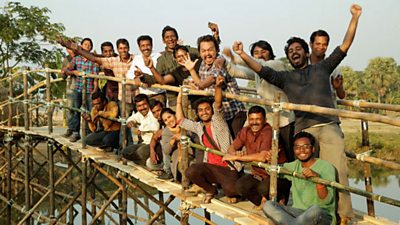Downloads
We have been working together [as a community] for a long time but we learnt [from Amrai Pari] that our togetherness is the key to solving any problem.
Amrai Pari (Together we can do it) is a reality TV show that reaches 15.8 million people. It aims to help communities in Bangladesh increase their resilience against environmental hazards. Our research revealed that Amrai Pari encourages communities to work together, provides new information and helps them to adopt new resilience-enhancing skills.
Publication date: April 2015
The project
Amrai Pari visits communities in the areas of the country most susceptible to environmental hazards and challenges them to work together - with their neighbours and local traders to make their infrastructure more weather-resistant and learn new resilience-enhancing techniques. By showcasing the success of real communities, the programme aims to help and encourage audiences to work together more in their own neighbourhoods and become more aware of better ways to prepare against the threat of environmental hazards.
Research approach
Βι¶ΉΤΌΕΔ Media Action conducted six community discussions in three different target areas: farming communities in the South West and North West and urban slum dwellers in Dhaka. The research established how target communities worked together to address environmental hazards and explored the influence of Amrai Pari in communities.
Key findings
- Despite facing very different hazards, all communities understood the need to prepare for and adapt to them. They prepared and responded to hazards when they felt that their livelihoods were under immediate threat or when actions directly helped them to make ends meet.
- Three factors had the most influence on community action. The more threatening people perceive local environmental hazards to be, the more likely they are to take action. Communities with high levels of collective efficacy had a better track record of taking action to improve their resilience.
- Communities tended to take action, if they felt empowered and there was support for their concerns at the local government level.
- Amrai Pari was perceived to be a unique programme. Audiences felt that it reinforced their commitment to work together - even when they lived in communities with a strong sense of collective efficacy.
- Audiences of Amrai Pari learnt new things from the programme and some individuals replicated resilience-enhancing techniques they had seen on the programme. They were especially interested in techniques that were easily replicable and made their daily lives easier.
- While audiences in all surveyed locations identified with the communities shown on Amrai Pari, many felt that their learnings could be improved if they could see more episodes that were specifically tailored to their local context.
Project context
A combination of poverty, high population density and low-lying geography makes Bangladesh particularly vulnerable to disasters. The situation is complicated by the diversity of natural hazards that different regions of Bangladesh face.
The North West part of Bangladesh experiences drought and unpredictability at the beginning of seasons; while the South West mainly experiences increased salinity and more frequent cyclones. People living in cities with populations exceeding one million (i.e. Dhaka and Chittagong) have distinct concerns and issues relating to service provision such as inadequate electricity and water supplies.
Learnings
Continue the format. Audiences were engaged in the programme and felt it encouraged working together and helped them to learn new resilience-enhancing techniques.
Showcase more economic benefits. Viewers most valued content that they felt helped them to improve their food security, helped them make money and make their homes more comfortable.
Inspire cooperation between leaders and communities. Often community members were unsure how they could overcome top-down power structures. Sometimes they felt that they required support from local NGOs and leaders; especially for larger projects such as building a dam. The programme can use its reality TV format to showcase how communities garner the support of influential stakeholders and tackle resilience projects together.
Inform audiences about the content of future programming. To ensure that audiences know when an episode will air that is especially relevant to their local context or individual needs, trailers could include information on future programming.
Expand the use of local partnerships. Amrai Pari is supported by outreach activities. These activities include training of local NGOs to improve their communication strategies on environmental issues, disaster response and preparation. The show could address the demand for more local information by further encouraging these NGO partners to provide instructive information
